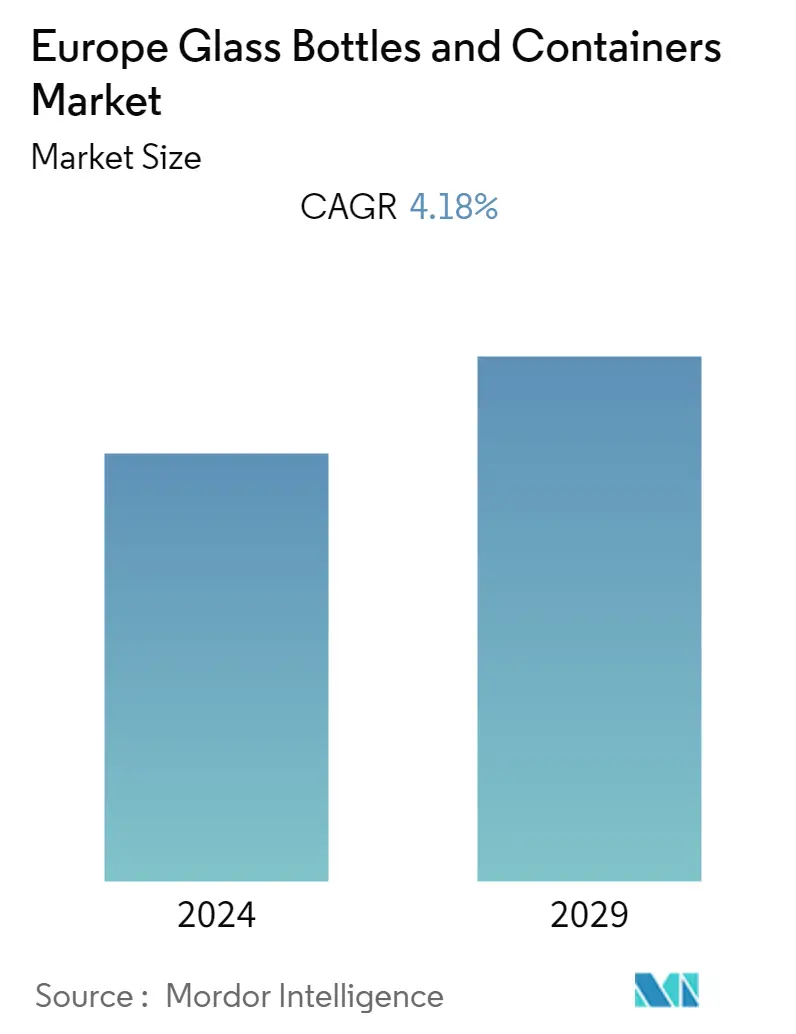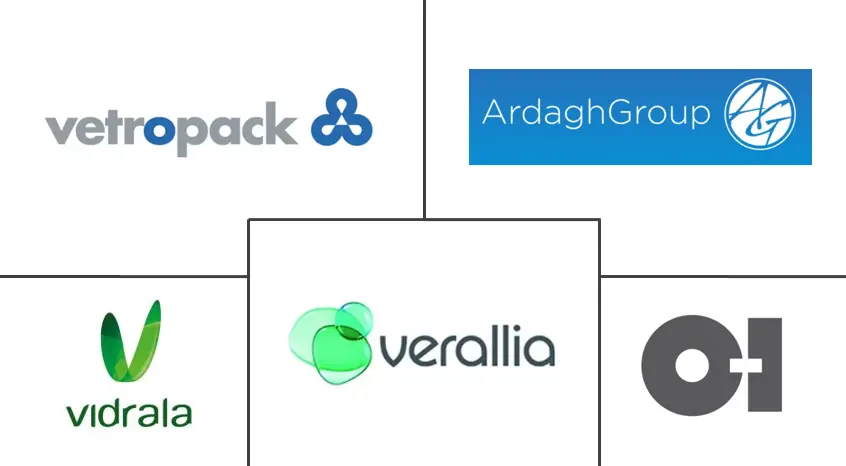Market Size of Europe Glass Bottles and Containers Industry

| Study Period | 2019 - 2029 |
| Base Year For Estimation | 2023 |
| Forecast Data Period | 2024 - 2029 |
| Historical Data Period | 2019 - 2022 |
| CAGR | 4.18 % |
| Market Concentration | Medium |
Major Players
*Disclaimer: Major Players sorted in no particular order |
Europe Glass Bottles & Containers Market Analysis
The European Glass Bottle and Containers Market is expected to grow at a CAGR of 4.18% during the forecasted 2021 to 2026. Glass packaging was considered an essential industry by most countries during the COVID-19 pandemic. There has been increased demand for glass packaging from the F&B industry and the pharmaceutical sector as the COVID-19 pandemic has led to greater demand for medicine bottles, food jars, and beverage bottles.
- Alcoholic drinks, like beer, accounted for the market's largest segment, as glass does not react with the chemicals present in drinks and, therefore, preserves the aroma, strength, and flavor of these beverages, making it a favorable option for packaging. Due to this, most of the beer volume is transported in glass bottles. This trend is expected to continue over the forecasted period. Glass packaging is 100% recyclable, making it a desirable packaging option from an environmental point of view.
- The introduction of stringent laws to enhance the quality and integrity of domestically manufactured drugs increases the use of glass for pharmaceutical packaging products. Additionally, the increasing demand for sterile medical packaging products from the pharmaceutical industries further drives the market growth over the forecast period.
- The trend of customization is also growing in the region, with demand for bespoke glass bottles increasing. The UK's best-selling kombucha tea is sold in new bespoke glass bottles manufactured by Rotherham glass manufacturer Beatson Clark.
- The glass production market declined in Europe during 2020, especially in Germany. However, the positive consumer sentiment towards sustainable production is expected to increase the demand.
- The pandemic brought adverse impacts on the glass container and bottle manufacturers in the region. In January 2021, the International Finance Corporation (IFC), the private investment arm of the World Bank Group, announced a USD 10 million loans to Kioo Limited to help the company weather the challenges created by the COVID-19 pandemic.
Europe Glass Bottles & Containers Industry Segmentation
The scope of the study covers the key end-user industries, such as beverage, food, pharmaceutical, and cosmetics. The study also covers beverage industry types such as liquor, beer, soft drinks, and milk.
Glass bottles and containers provide an ideal way to keep the consumables safe, fresh, and healthy for a more extended period and ease transport. Glass bottles and containers are majorly used in the alcoholic and non-alcoholic beverage industry due to their ability to maintain chemical inertness, sterility, and non-permeability.
| End-user Industry | ||||||||
| ||||||||
| Food | ||||||||
| Cosmetics | ||||||||
| Pharmaceutical | ||||||||
| Other End-user Industries |
| Country | |
| United Kingdom | |
| Germany | |
| France | |
| Italy | |
| Spain | |
| Poland | |
| Russia | |
| Netherlands | |
| Rest of Europe |
Europe Glass Bottles and Containers Market Size Summary
The European Glass Bottles and Containers Market is poised for steady growth, driven by increasing demand from the food and beverage industry, as well as the pharmaceutical sector. The COVID-19 pandemic highlighted the essential nature of glass packaging, with a surge in demand for items such as medicine bottles and food jars. The beverage segment, particularly alcoholic drinks like beer and wine, dominates the market due to glass's non-reactive properties, which help preserve the quality of these products. The trend towards sustainability is also a significant factor, as glass packaging is fully recyclable, aligning with environmental goals. The market is experiencing a shift towards customization, with bespoke glass bottles gaining popularity, further fueling market expansion.
The market landscape is moderately fragmented, with key players like Owens Illinois, Ardagh Group, and Verallia leading the charge. Strategic partnerships and acquisitions are common as companies seek to enhance their offerings and expand their market reach. For instance, collaborations aimed at improving glass packaging efficiency and sustainability are becoming more prevalent. The German market, known for its robust recycling systems, plays a crucial role in driving circularity and resource efficiency. Despite challenges such as bottle shortages in the beer and wine sectors, the overall sentiment towards sustainable production and innovative packaging solutions remains positive, supporting the market's growth trajectory.
Europe Glass Bottles and Containers Market Size - Table of Contents
-
1. MARKET DYNAMICS
-
1.1 Market Overview
-
1.2 Market Drivers
-
1.2.1 Growing Demand for Bottled Beverages is Driving the Market in the Wine Industry
-
1.2.2 Increased Integration in the Premium Packaging Market Further Drives the Growth
-
-
1.3 Market Restraints
-
1.3.1 People's Attitude Towards Sustainable Forms of Packaging
-
-
1.4 Influence of COVID-19 on glass bottles industry in Europe
-
1.5 Value Chain Analysis
-
1.6 Porters Five Force Analysis
-
1.6.1 Threat of New Entrants
-
1.6.2 Bargaining Power of Buyers
-
1.6.3 Bargaining Power of Suppliers
-
1.6.4 Threat of Substitute Products
-
1.6.5 Intensity of Competitive Rivalry
-
-
-
2. MARKET SEGMENTATION
-
2.1 End-user Industry
-
2.1.1 Beverages
-
2.1.1.1 Liquor
-
2.1.1.2 Beer
-
2.1.1.3 Soft Drinks
-
2.1.1.4 Milk
-
2.1.1.5 Water (Carbonated & Still)
-
2.1.1.6 Wine
-
-
2.1.2 Food
-
2.1.3 Cosmetics
-
2.1.4 Pharmaceutical
-
2.1.5 Other End-user Industries
-
-
2.2 Country
-
2.2.1 United Kingdom
-
2.2.2 Germany
-
2.2.3 France
-
2.2.4 Italy
-
2.2.5 Spain
-
2.2.6 Poland
-
2.2.7 Russia
-
2.2.8 Netherlands
-
2.2.9 Rest of Europe
-
-
Europe Glass Bottles and Containers Market Size FAQs
What is the current Europe Glass Bottles and Containers Market size?
The Europe Glass Bottles and Containers Market is projected to register a CAGR of 4.18% during the forecast period (2024-2029)
Who are the key players in Europe Glass Bottles and Containers Market?
Owens Illinois, Ardagh Group, Vidrala, Vetropack Holdings Ltd. and Verallia (Horizon Holdings II SAS) are the major companies operating in the Europe Glass Bottles and Containers Market.

